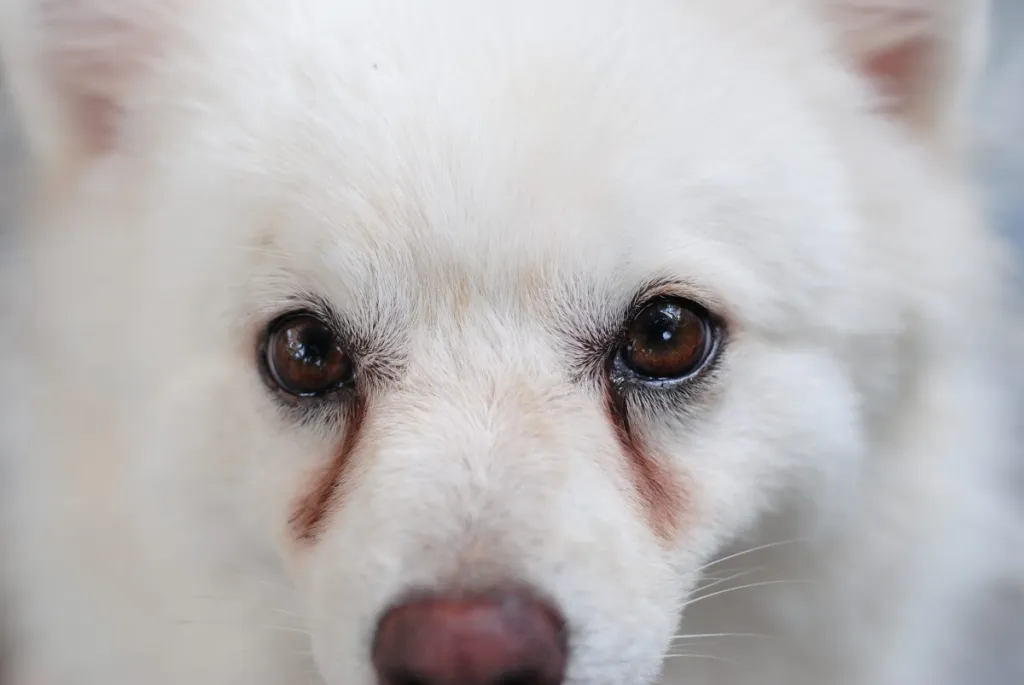Tear stains on dogs can be a common and sometimes puzzling sight for pet owners. These stains, which often appear as reddish-brown streaks under the eyes, can indicate various underlying issues or simply be a cosmetic concern. In this guide, we’ll delve into the reasons behind tear stains, what they might signify about your dog’s health, and effective ways to prevent and manage them.
What Are Tear Stains?
Identifying Tear Stains
Tear stains are discolored marks that typically appear on the fur beneath a dog’s eyes. They are most noticeable on dogs with lighter-colored coats, where the reddish-brown or dark discoloration stands out against the fur. Tear stains are caused by excessive tearing, which can lead to the accumulation of tear fluid and its subsequent reaction with bacteria or yeast on the fur.
Common Causes of Tear Stains
Understanding the Root Causes
Several factors can contribute to the development of tear stains in dogs. It’s essential to identify these causes to determine the appropriate course of action for managing and treating tear stains effectively.
Tear Duct Anatomy
Some dogs, particularly those with short or flat faces (brachycephalic breeds like Pugs or Bulldogs), have shallow tear ducts. This anatomical feature can lead to poor tear drainage, causing tears to overflow onto the face rather than draining properly through the tear ducts.
Allergies and Irritants
Allergies to food ingredients, environmental allergens (like pollen or dust), or irritants (such as cigarette smoke or cleaning products) can cause excessive tearing in dogs. The resulting tears can contribute to tear stains, especially if the fur around the eyes becomes damp and prone to staining.
Eye Infections or Irritations
Conjunctivitis (commonly known as pink eye) or other eye infections can cause increased tear production in dogs. Similarly, irritants like dust or debris can lead to watery eyes and subsequent tear stains if not promptly addressed.
Epiphora
Epiphora refers to excessive tearing that isn’t necessarily caused by an underlying health issue but rather due to the shape or structure of the dog’s face. Breeds with prominent eyes, such as Shih Tzus or Maltese, may experience epiphora simply due to their facial anatomy.
Health Concerns Associated with Tear Stains
When to Be Concerned
While tear stains themselves are usually harmless from a health perspective, they can sometimes indicate underlying health issues that require veterinary attention.
Infections
Persistent tear stains accompanied by redness, swelling, or discharge from the eyes could indicate an infection that needs treatment. Bacterial or yeast infections can exacerbate tear staining and lead to discomfort for your dog if left untreated.
Blocked Tear Ducts
In some cases, tear staining may be caused by blocked tear ducts, preventing tears from draining properly. This condition can lead to eye irritation and requires veterinary intervention to resolve.
Corneal Ulcers
Excessive tearing combined with squinting or pawing at the eyes may indicate a corneal ulcer, a serious condition that requires immediate veterinary attention to prevent vision loss.
Managing and Preventing Tear Stains
Effective Strategies for Tear Stain Control
Managing tear stains involves addressing the underlying causes and implementing strategies to minimize tear production and prevent staining of the fur.
Regular Grooming
Regularly cleaning the area around your dog’s eyes with a damp cloth or pet-safe wipes can help prevent tear stains from becoming pronounced. Be gentle to avoid irritating the sensitive skin around the eyes.
Diet and Nutrition
Reviewing your dog’s diet may help manage tear stains, especially if allergies are suspected. Some dogs may benefit from switching to a hypoallergenic diet or one that reduces tear production.
Veterinary Consultation
If tear stains persist despite your efforts, consult with your veterinarian to rule out any underlying health issues. They may recommend topical treatments, dietary changes, or medications to address the problem effectively.
Home Remedies and Treatments for Tear Stains
Natural Approaches and Products
Several home remedies and commercial products are available to help reduce tear stains. It’s essential to choose safe and effective options and consult with your vet before trying new treatments.
Natural Tear Stain Removers
Ingredients like witch hazel, apple cider vinegar, or saline solution can be used to gently cleanse tear-stained fur. However, always dilute these solutions appropriately and avoid getting them into your dog’s eyes.
Commercial Tear Stain Products
There are numerous over-the-counter tear stain removers, wipes, and powders available. Look for products specifically formulated for dogs, and follow the manufacturer’s instructions carefully to achieve the best results.
Conclusion
Understanding the causes and implications of tear stains on your dog is crucial for their health and well-being. While tear stains are often a cosmetic issue, they can sometimes signal underlying health concerns that require veterinary attention. By identifying the root causes and implementing appropriate management strategies, you can help keep your dog comfortable and their eyes clear of unsightly stains.
- Best LeadsGorilla Alternatives for 2025 - April 19, 2025
- Best Coldlytics Alternatives for 2025 - April 19, 2025
- Best Brevo Alternatives for 2025 - April 18, 2025



